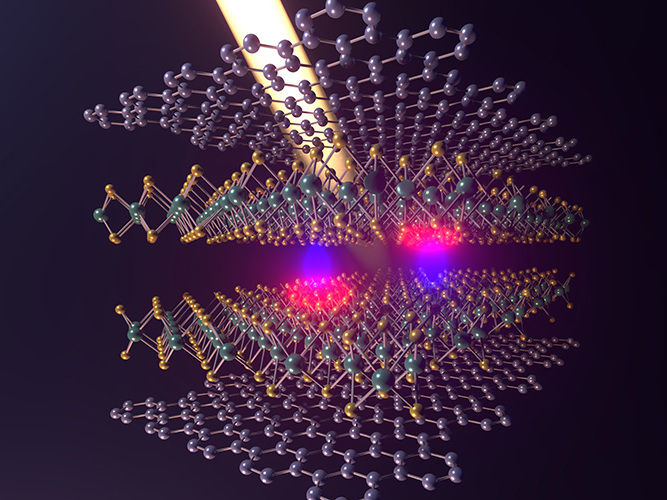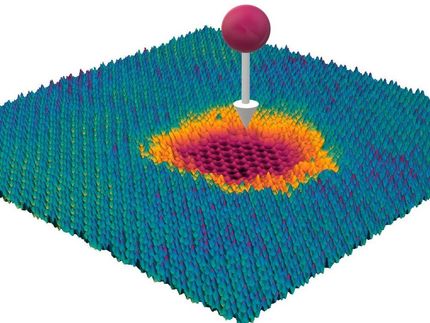A highly light-absorbent and tunable material
New approach to developing optoelectronic devices
By layering different two-dimensional materials, physicists at the University of Basel have created a novel structure with the ability to absorb almost all light of a selected wavelength. The achievement relies on a double layer of molybdenum disulfide. The new structure’s particular properties make it a candidate for applications in optical components or as a source of individual photons, which play a key role in quantum research.

Schematic illustration of the electron-hole pairs (electron: pink, hole: blue), which are formed by absorption of light in the two-layer molybdenum disulfide layer.
Nadine Leisgang and Lorenzo Ceccarelli, Department of Physics, University of Basel
Novel two-dimensional materials are currently a hot research topic around the world. Of special interest are van der Waals heterostructures, which are made up of individual layers of different materials held together by van der Waals forces. The interactions between the different layers can give the resulting material entirely new properties.
Double layer unlocks crucial properties
There are already van der Waals heterostructures that absorb up to 100 percent of light. Single-layers of molybdenum disulfide offer absorption capacities in this range. When light is absorbed, an electron vacates its original position in the valence band, leaving behind a positively charged hole. The electron moves to a higher energy level, known as the conduction band, where it can move freely.
The resulting hole and the electron are attracted to each other in accordance with Coulomb’s law, giving rise to bound electron-hole pairs that remain stable at room temperature. However, with single-layer molybdenum disulfide there is no way to control which light wavelengths are absorbed. “It is only when a second layer of molybdenum disulfide is added that we get tunability, an essential property for application purposes,” explains Professor Richard Warburton of the University of Basel’s Department of Physics and Swiss Nanoscience Institute.
Absorption and tunability
Working in close collaboration with researchers in France, Warburton and his team have succeeded in creating such a structure. The physicists used a double layer of molybdenum disulfide sandwiched between an insulator and the electrical conductor graphene on each side.
“If we apply a voltage to the outer graphene layers, this generates an electric field that affects the absorption properties of the two molybdenum disulfide layers,” explains Nadine Leisgang, a doctoral student in Warburton’s team and lead author of the study. “By adjusting the voltage applied, we can select the wavelengths at which the electron-hole pairs are formed in these layers.”
“This research could pave the way for a new approach to developing optoelectronic devices such as modulators,” adds Richard Warburton. Modulators are used to selectively change a signal’s amplitude. Another potential application is generating individual photons, with important implications for quantum technology.
Original publication
Nadine Leisgang, Shivangi Shree, Ioannis Paradisanos, Lukas Sponfeldner, Cedric Robert, Delphine Lagarde, Andrea Balocchi, Kenji Watanabe, Takashi Taniguchi, Xavier Marie, Richard J. Warburton, Iann C. Gerber and Bernhard Urbaszek; "Giant Stark splitting of an exciton in bilayer MoS2"; Nature Nanotechnology; 2020
Most read news
Original publication
Nadine Leisgang, Shivangi Shree, Ioannis Paradisanos, Lukas Sponfeldner, Cedric Robert, Delphine Lagarde, Andrea Balocchi, Kenji Watanabe, Takashi Taniguchi, Xavier Marie, Richard J. Warburton, Iann C. Gerber and Bernhard Urbaszek; "Giant Stark splitting of an exciton in bilayer MoS2"; Nature Nanotechnology; 2020
Organizations
Other news from the department science

Get the chemical industry in your inbox
By submitting this form you agree that LUMITOS AG will send you the newsletter(s) selected above by email. Your data will not be passed on to third parties. Your data will be stored and processed in accordance with our data protection regulations. LUMITOS may contact you by email for the purpose of advertising or market and opinion surveys. You can revoke your consent at any time without giving reasons to LUMITOS AG, Ernst-Augustin-Str. 2, 12489 Berlin, Germany or by e-mail at revoke@lumitos.com with effect for the future. In addition, each email contains a link to unsubscribe from the corresponding newsletter.
Most read news
More news from our other portals
Last viewed contents

BASF and NEVEON co-operate on mattress recycling - First trials on chemical recycling of mattresses successful





























































